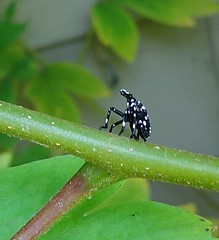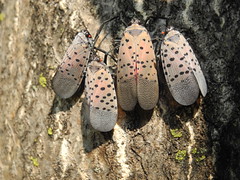what to do if i see a spotted lanternfly
On this page:
-
What Practise Spotted Lanternflies Await Like?
-
Should I Worry About Spotted Lanternflies?
-
What if I Find a Spotted Lanternfly for the Start Time?
-
How did Spotted Lanternflies Get to My One thousand and Other New Places?
-
How Do I Manage Spotted Lanternflies?

Spotted lanternflies are named after flies, look similar moths, but are actually planthoppers. They take piercing-sucking mouthparts which allow them to drill into the phloem of a establish to feed straight on the sugary sap—which comes out their other stop as sticky, sweet honeydew.
This planthopper is idea to have arrived as egg masses on a stone shipment in 2012. The first infestation was found in Berks County, Pennsylvania in 2014 in a wooded area of Ailanthus altissima, the Tree of Heaven. Despite a quarantine of the townships involved, and efforts to eradicate this pest, the spotted lanternfly has proved hard to contain and its range now includes infestations in New York.
What Do Spotted Lanternflies Look Like?
The name lanternfly is misleading; spotted lanternflies have little in common with any type of fly. Another misconception arises when viewing adults with wings spread, making them look like moths. Spotted lanternflies are planthoppers in the social club Hemiptera, or true bugs, and are more than closely related to cicadas, dark-brown marmorated stink bugs, aphids, and leafhoppers.

The commencement instar nymphs are active from May until July and are approximately ¼" long and black with white spots. They are occasionally mistaken for ticks. 2nd and third instar nymphs are as well black with white spots.

Fourth instar nymphs take on a red coloration with white spots and can be up to ¾". This phase is active from July through mid-August; they then molt and go adults. All nymphal stages and adult spotted lanternflies can apply their powerful hind legs to jump impressive distances.

Many photos show adult SLF with their wings open, including the red underwings, but in nature this only occurs when the SLF is startled or is ready to take flying. It is much more common to run across the 1" adults at rest with black-spotted, pinkish-tan wings folded over their backs. Both male and female SLF accept yellow abdomens with blackness stripes.
Click hither for more information on Biology: Life Cycle, Identification, and Dispersion.
Return to top
Should I Worry About Spotted Lanternflies?
Spotted lanternflies do not bite or sting. They feed exclusively on plants outdoors and can but survive for nigh 48 hours without feeding on a plant. In natural and residential areas, they feed on Tree of sky (Ailanthus), blackness walnut, maples (they will preferentially feed on silvery maple, and so red maple), willow, river birch, black carmine, tulip poplar, and other trees. Like agronomical crops (with the exception of grapes), they do not appear to be dissentious trees. They tin, however, be a nuisance because of their sheer numbers.

Considering spotted lanternfly, a phloem feeder, consumes large quantities of a plant's sugary sap to extract nitrogen and amino acids, it expels large quantities of excess sugar-water (honeydew). Honeydew—ofttimes misidentified equally sap—shows up on outdoor equipment, decking, and vehicles too as pets and your article of clothing and hair. Left to accumulate outdoors, honeydew acts as a growth medium for thin, dark layers of sooty mold fungi. Bees and wasps are too attracted to the sweet, then there tin be an increased stinging chance around infested plants.

Click here for more information about Host Plants.
Click hither for more information on Damage.
Spotted lanternfly has proven to exist a serious pest of grapes (both cultivated and wild). They are swarm feeders and upward to 400 SLF adults per vine have been reported. Feeding past a population this high has been shown to weaken the vine, leading to loss of winter hardiness, reduced or no return flower or ingather, and even vine decease. They don't seem to be causing pregnant damage to agricultural crops like hops, apples, or peaches, but the event is however being studied.
Return to top
How did Spotted Lanternflies Go to My G and Other New Places?
Spotted lanternflies are common hitchhikers at all life stages, just adults and egg masses are nigh commonly moved. Adults volition fly into open windows of vehicles, into picking bins, and into the back of trucks while they are existence loaded; eggs can exist establish on nearly any outdoor surface. Transportation by homo activity is the most common form of movement and the main reason SLF populations have spread significant distances.

Moving an outdoor item that unknowingly has an egg mass to a new location is a mutual way spotted lanternflies spread to a new location. Common items on which egg masses have been laid include firewood, motor homes, recreational vehicles, edifice materials, and even kiddie pools. To reduce the hazard of these hitchhiking pests, the NYSIPM Program has created a SLF Checklist to utilise when visiting an area with known populations of SLF.
Return to top
What if I Find a Spotted Lanternfly for the First Time?

If it is not known to occur in your area or y'all're not sure if information technology does, we want to know about it! Send an electronic mail with location information and photos to: spottedlanternfly@agriculture.ny.gov.
Early on detections are especially important to help protect agricultural crops that might be affected.
Return to elevation
How Practise I Manage Spotted Lanternflies?
Traps
Traps can be useful to catch the SLF nymphs and adults as they climb the tree trunk. The traps are all-time gear up past early May to capture the nymphs every bit they emerge from the egg masses. Although the traps may grab large numbers of the insects it will non completely prevent SLF's presence on that tree. Many egg masses could accept been laid in the tree canopy above the trap, and the developed stage can fly into the higher branches without climbing the body.

Sticky Band Traps - These traps encircling the torso tin be constructive merely they must be accompanied past a bulwark to forestall the capture of beneficial insects and animals such as birds. A slice of vinyl window screening secured above the viscous band, secured with push pins at the peak and flared out at the bottom several inches beneath the ring can help prevent unintentional catches of other insects and birds.
Circle Traps - These traps consist of screening that encircles the torso which funnels climbing spotted lanternflies into a container at the top from which they cannot escape. Our friends at Penn Country created a detailed guide on how to build a circumvolve trap.
Pesticides
Since spotted lanternflies rarely cause impairment to landscape trees, treatment is not necessary for the health of the tree; just if they become a nuisance, insecticides can be used. Some people may cull to hire a certified pesticide applicator who is equipped to make a tree injection, bawl sprays, or soil drenches. There are a few pesticide products labeled for use by residents in New York. They can be found at the bottom of a downloadable table here.
For safety and legal applications, it is always important to read and follow the product label earlier applying whatever pesticide.
Mechanical

Scraping Egg Masses - Late fall, after spotted lanternflies are killed by freezing temperatures and earlier they hatch in May, is a good time to await for and remove egg masses. Check for the egg masses on tree trunks, branches, rocks, lawn furniture, and really anything that's outside. The egg masses are often plant on the underside of branches or objects and vary in size, just are typically almost 1 1/ii" long and and 3/iv" broad and wait like grayish splotches of mud or putty. Scrape these egg masses into a re-sealable bag which contains rubbing alcohol or hand sanitizer and dispose of them in the solution to exist bodacious they volition not hatch.
Because spotted lanterflies lay many egg masses high up in tree canopies, removing egg masses inside reach will non eliminate them, but because each egg mass contains upwardly to 50 eggs, it can reduce the numbers, especially early in the season.
Render to top
mcmullencuble1953.blogspot.com
Source: https://nysipm.cornell.edu/whats-bugging-you/spotted-lanternfly/
0 Response to "what to do if i see a spotted lanternfly"
Post a Comment